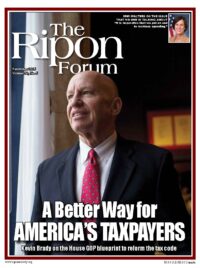
The presidential campaign is coming to a close with both of the major-party candidates having managed to avoid clear answers about what they would do to put the federal budget on a sustainable path.
The omission is striking for two main reasons.
First, the growing national debt is a threat to the economic well-being of future generations and deserves the attention of anyone aspiring to become president.
And second, the American people have a right to know what the candidates plan to do about such a major problem.
Glossing over the issue during the campaign, as the candidates have done, just makes it harder for the winner to propose serious solutions once he or she takes office. They have built in unrealistic expectations that when exposed to real-world budgeting will soon come crashing down, increasing public cynicism.
The first reality test will come shortly after taking office when either Hillary Clinton or Donald Trump will have to submit a Fiscal Year 2018 budget to Congress against the backdrop of rising deficits and debt.
The growing national debt is a threat to the economic well-being of future generations and deserves the attention of anyone aspiring to become president.
Consider what awaits the next occupant of 1600 Pennsylvania Avenue:
For the first time since 2009, the federal budget deficit increased in the recently ended fiscal year, going from $438 billion (2.5 percent of GDP) in 2015 to $587 billion (3.2 percent of GDP) in 2016.
The upward trend will continue under current law with the deficit projected to reach $1.2 trillion (4.6 percent of GDP) in 2026. Deficits have averaged 2.8 percent of GDP over the past 50 years.
Federal debt held by the public is projected to grow from 77 percent of GDP this year (the highest level since 1950) to 86 percent in 2026, far above the average over the past 50 years (39 percent of GDP).
Beyond the next decade, the nonpartisan Congressional Budget Office (CBO) projects that the debt will continue rising under current law, reaching 141 percent of GDP 30 years from now. The highest recorded debt level in U.S. history was 106 percent of GDP in 1946.
The nation deserves a candid discussion of the budget outlook and the forces that are driving the debt higher: population aging and health care costs.
According to the latest CBO projections, 82 percent of federal spending growth over the next 10 years will be driven by major health care programs (34 percent of the increase), Social Security (29 percent of the increase), and interest on the debt (19 percent of the increase).
Federal debt held by the public is projected to grow from 77 percent of GDP this year to 86 percent in 2026, far above the average over the past 50 years.
Clinton and Trump have both made some expensive proposals but neither has proposed anything to change the upward trajectory of debt.
It’s not as if the numbers have no connection to the future economy.
A high national debt leads to increased government borrowing, which crowds out productive investments in people, machinery, technology and research, resulting in slower economic growth and lower wages.
Growing debt also crowds out public investment by requiring an increasing share of the budget to go towards interest payments instead of into new public investments in education, infrastructure, and research and development.
Indeed, federal investment spending has already been declining for years. Forty years ago the government spent 4.1 percent of GDP and 22 percent of the budget on investments. It now spends only 2.7 percent of GDP and 13 percent of the budget on investments. During that time, transfer payments have increased from 48 percent of the budget to 71 percent.
On the other hand, reducing deficits can be a source of strength. According to CBO, a responsible deficit-reduction plan ($2 trillion over 10 years) could boost real per-person output by about $5,000 in 2046.
Moreover, there is a substantial cost to delay. According to CBO, waiting five years to begin reforms aimed at stabilizing the current debt-to-GDP ratio in 2040 would increase the cost by about one-third. Waiting 10 years would increase the cost by two-thirds. Delay also shifts more of the burden to future generations.
What do the candidates have to say about this? Not much.
Hillary Clinton says her new spending plans would not add a penny to the debt because she has proposed higher taxes on the wealthy to pay for them. Even assuming the accuracy of this assertion, her proposals would still not address the unsustainable path we’re already on.
Donald Trump says that his plan to aggressively cut taxes will be paid for by cutting waste, fraud and abuse and by a huge boost in economic growth stimulated by the tax cuts. The spending cuts, however, are mostly unspecified and the rate of economic growth he assumes as the result of his tax cuts is beyond the range considered plausible by most nonpartisan analysts. The most likely scenario is that Trump’s proposals, if enacted, would make the debt outlook worse. But, as with Clinton, even if his assumptions were correct paying for his new proposals would still leave us on an unsustainable path.
With the campaign wrapping up, it seems unlikely that either candidate will now come forward with new, more credible, ideas for putting the budget on a sustainable path. Attention must be turned toward what they will propose in the first budget the November winner will produce next year.
While it would nice to think that the first budget will contain a comprehensive proposal dealing with Social Security, health care and taxes, a more realistic scenario would concentrate on a few defined prospects for change that could engender a bipartisan compromise and make incremental progress on the long-term fiscal outlook.
Focusing on Social Security alone might be a possibility. Another would be a compromise on infrastructure spending and tax reform. In either case, some element of compromise would be essential for laying the groundwork for future negotiations by rebuilding trust across the vast partisan divide.
One thing is clear. If the next president doesn’t come up with something better than we have seen on the campaign trail, our fiscal challenges will fester and grow.
Treading water is not enough.
Robert L. Bixby is Executive Director of The Concord Coalition.




